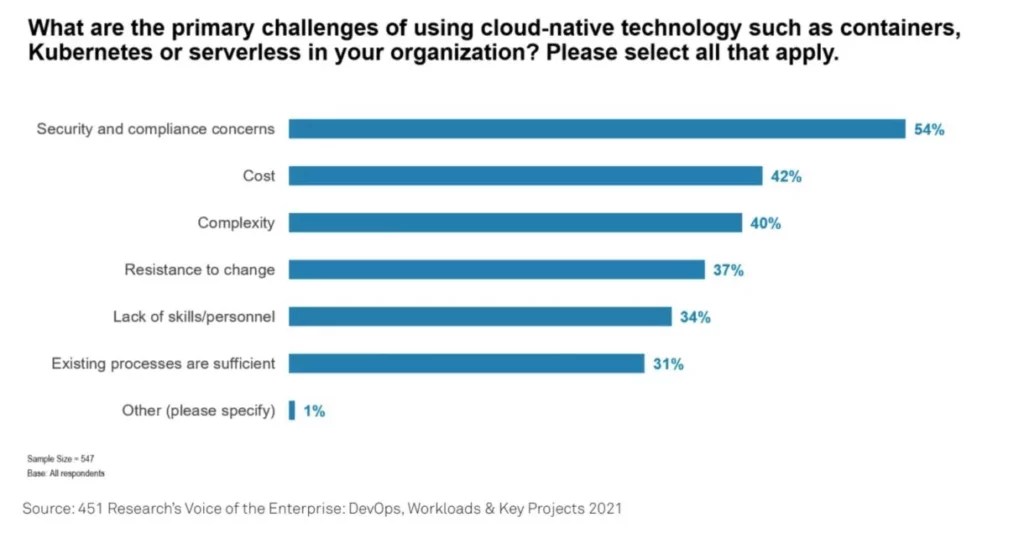Cloud native observability challenges
For organizations with cloud-native environments, containers and microservices are helping them achieve IT operations efficiency, improved developer productivity, and better application portability.
But what has come with this approach to app development is a new set of monitoring challenges due to the complexity and dynamic nature of cloud-native applications. As companies build on cloud-native services, they need an observability solution that is even more reliable than the product or service being monitored, and most legacy cloud-hosted APM (application performance monitoring) systems fall short.
As a result, organizations are taking a fresh look at tools available to monitor their cloud-native apps, and they are increasingly choosing new observability vendors offering purpose-built cloud-native monitoring platforms.
“The fact that many organizations have engaged new vendors indicates that cloud-native continues to be an arena where new vendors can differentiate with purpose-built systems designed with cloud-native technologies in mind,” according to 451 Research’s report, For cloud-native monitoring, most enterprises employ multiple approaches to meet their needs.
In a recent report and related survey, summarized below, 451 Research examines:
- Challenges of using cloud-native technologies.
- Approaches organizations are taking in monitoring their cloud-native apps.
- How changing requirements are creating opportunity for new cloud-native vendors offering purpose-built observability platforms.
Complexity a top challenge in cloud-native environments
Cloud-native applications are designed to be more scalable, reliable, and flexible than monolithic applications running on VMs. But, according to 451 Research, “highly distributed microservices-based applications can be complex and the number of interconnected microservices can generate large amounts of telemetry to be stored and analyzed.”
In fact, according to 451 Research’s Voice of the Enterprise: DevOps, Workloads & Key Projects survey, complexity (40% of respondents) was one the top three challenges for organizations using cloud-native technology. Security and compliance (54%) and Cost (42%) were also top concerns.
“As more organizations draw on microservices-based architectures supported by newer technologies that are seeing more mainstream adoption, such as Kubernetes and serverless, enterprises have had to contend with new operational challenges. Without adequate tooling or processes in place, the growing complexity of cloud-native apps can be in direct opposition to the desire to maintain visibility and ensure service level objectives,” according to 451 Research.
New observability tools close second to legacy APMs
According to 451 Research, organizations with cloud-native environments have multiple monitoring options to choose from, whether that means leveraging legacy APM tools, new observability platforms, open source software (OSS), DIY (do it yourself) tooling, or a combination.
For their part, legacy APM vendors – which have made acquisitions to help catch up on capabilities – appear to organizations as large and potentially expensive platforms, even if they intend to reduce tool sprawl. No surprise, given the power of the legacy customer base, 50% of respondents in 451 Research’s survey said they are purchasing from their existing monitoring vendor.
Significantly, however, new observability vendors are running a close second to legacy APMs, with nearly half (44%) of respondents saying they are purchasing monitoring tools from new providers.
This is good news for new observability vendors like two-and-a-half-year-old Chronosphere.
According to 451 Research, “The relatively high number of organizations purchasing from new vendors (44%) highlights the notion that despite the expanding portfolios of incumbent players and the desire to reduce tool sprawl, customers are still interested in a best-of-breed approach when necessary.”
451 Research also noted that startups such as Chronosphere “aim to show customers that newer technologies can best be met by more recently engineered products that have been purpose-built with cloud native in mind.”
A few additional data points highlighted by 451 Research emphasize the inroads open source software is making. “With the proliferation of OSS (open source software) such as *Prometheus and FleuntD (Cloud Native Computing Foundation projects), we expect that many organizations using vendor-supported or even DIY tooling are drawing on pieces of OSS to some degree since usage of Prometheus will underpin Kubernetes monitoring tools from many vendors.”
According to the 451 Research report, DIY tooling and OSS use were:
- Much more likely (51%) for organizations that have adopted DevOps across 100% of their organization.
- Compared to organizations with just some adoption of DevOps (34%).
“This may also be an indicator of the scale of cloud-native apps in those organizations because a ‘roll your own’ approach can quickly become costly and time-consuming to manage, and these organizations may in time opt for support from vendors,” according to 451 Research.
*Chronosphere is open-source compliant, and fully supports Prometheus metrics ingest protocols, dashboards, and query languages.
Download and read the full report.






